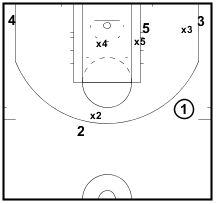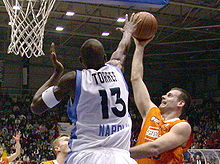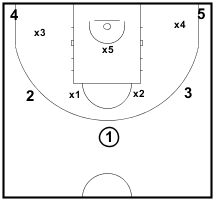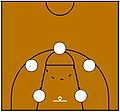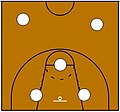Defense (basketball)
The defense (also defensive or English defense ) pursues the goal of basketball to prevent an opposing basket success, or to get into possession of the ball before the throw, or after an unsuccessful throw attempt.
There are different defense systems in basketball. The best-known defense systems are the man-man defense, in which each player is assigned a direct opponent, and zone defense , i.e. the formation of the defending players in a predetermined formation around their own basket. There are also numerous mixed forms, such as the box and one and triangle and two systems . Depending on the defense system, the players position themselves in a certain way on the field of play, whereby a dynamic change between the forms of defense may be necessary due to offensive actions or changes in the line-up of the attacking team. With the respective forms one further distinguishes whether one defends over the whole field (English full court ) or over half the field (English half court ). There is also the option of stealing the ball from the opponent by setting traps or forcing him to steal the ball .
Basics
The general goal in basketball is to score more points than your opponent. Since this is a so-called highscoring game , so there are a lot of successful points won, the main objective in defense is to minimize the chances and possibilities of the attacking team to win a basket. The defense can achieve this by trying to stop an attack by the opposing team by forcing a loss of the ball ( turnover ) before the throw, for example by a bad pass or an offensive foul. It can also try to prevent a throw until the 24 seconds attack time has elapsed , or it can force the opponent to throw a throw with a low chance of success (emergency throw, distance throw against defender).
In modern basketball there is basically no distinction between defensive and offensive players, rather all five players are usually involved in defending their own basket. Since each player acts as a defender for around half of the playing time during a game, the defense in basketball, as in other team sports, is just as decisive as the offensive of a team. It is even classified as more important in some cases, for example through the old team sport wisdom: " Offense wins Games, Defense wins Championships. “(The attack wins games, the defense wins championships.) Is expressed, and also in a quote based on the successful basketball coach Pat Summitt , who is one of the most successful college coaches of all time with eight NCAA titles:
"Offense sells tickets, defense wins games, rebounding wins championships."
"The attack sells tickets, the defense wins games, rebounds win championships."
Basically it can be assumed that defenders are at a disadvantage. Successful defense requires that the defenders act actively instead of waiting and reacting to the attacker. The right to the defense in basketball setting , as well as concentration and teamwork required and the defender should always have the ball in sight and bad passes the attacker already possible to anticipate ( anticipation ). Verbal exchange and well-rehearsed non-verbal communication between the players is of great importance for the success of a group in almost every team sport, including basketball. And so all five basketball defenders have to react verbally and physically to each other to ensure a good team defense.
Defense position
In order to be able to react quickly to the attacker's actions, the defender takes the normal basketball defensive position. To do this, he shifts his center of gravity down by kneeling slightly and lowering his buttocks. The distance between the feet should be approximately the width of the defender's shoulder. If the defender now wants to move with the attacker carrying the ball, he has to perform so-called defense slides (German defensive steps). He pushes off with his back foot and at the same time moves his front foot in the same direction as the attacker. His goal is to always stay between the attacker and the basket to be defended.
On the one hand, it is important to adopt the usual basketball posture, but the positioning of the defender on the basketball court is also crucial. The defenders off the ball must move with the ball and change their position in relation to the ball with each pass. It is important not to lose sight of your own attacker. If the defender overcome the ball carrier, it is for the other defenders to help out (Engl. Help defense ) to prevent a basket success.
In order to be able to record an offensive foul, a rule-compliant and legal defensive position must be taken. It is important that the defender has both feet on the ground and the attacker is facing. In order to maintain his legal defensive position, the defender is also allowed to temporarily lift one or both feet off the floor as long as the movement is not in the direction of the player in possession of the ball. If there is head-on contact, the attacker has committed an offensive foul and the defender wins the ball. If the contact is on the side of the body, the defender has taken the position too late and it is punished as a defense foul. An exception to this is the so-called no-charge semi-circle (a semicircle with a radius of 1.25 meters below the basket). In this area, the defender is no longer able to take an offensive foul if he has at least one foot inside or on the line of the circle.
Disability
The offensive of the attacking team usually has a certain rhythm that can be disturbed by pressure on the ball and by covering the other players. This increases the probability of successfully stopping the attack.
In addition, attempts can also be made to prevent an attacking player from getting the ball at all. On the one hand, this can be achieved by pressure on the build -up player or by adjusting the pass path ( overplay ). A defender stands in such a way that he obstructs the pass between the player in possession of the ball and the possible receiver. He either prevents the pass from being played at all or he speculates on winning the ball ( steal ) if the pass is played. The risk here is that failure can result in very easy points for the opposing team. This is why this form is usually played in secret to set a trap for the attacker. Often the steal is not attempted by the direct opponent of the player in possession of the ball. In addition, the attacker carrying the ball can make it more difficult to play a pass by holding a hand in front of his face and thus significantly restricting his field of vision. If a pass is played, the defense regroups itself at the moment the ball is released (not when it is caught) and adapts to the new ball-bearing player.
Litter disability
In general, the attacking team should not be allowed any throws from promising positions. To do this, a defender should position himself between the player in possession and the basket. To prevent a direct throw, he should be close to the attacker. In order to prevent the attacker from being pulled to the basket (English: penetration , dt. ' To penetrate, break through'), however, the defender needs some distance in order to be able to react if necessary. If the penetration cannot be prevented, a second defender is usually used ( help defense ), with strong attacking players often being doubled. If the attacker starts a throw anyway, the defender still has the option of making the attacker's throw more difficult by holding a hand in front of his face or by trying to block the throw. According to the basketball rules, it is a block as long as the ball has not passed the highest point of its trajectory and the ball has not touched the board of the basket. If the defender only touches the ball in the downward direction or after the ball has touched the board, it is a goaltend and the points are still awarded.
Positional obstruction
In addition to preventing penetration of the player in possession of the ball, it also makes sense to obstruct the paths of the other attacking players or even prevent them from reaching their intended position. For example, the center should be kept away from the basket, a bad instead of a good shooter should be on the line of three or simply the opponent's rhythm should be disturbed.
rebound
At the moment of a throw the fight for the rebound begins , the rebound from the board or ring (English rebound for 'rebound'). Short throws lead to rebound situations near the basket. The big players get into position and use their bodies to create space for themselves (boxing out or blocking out). It is the responsibility of each defender to lock an attacker out and to keep him out of the basket in order to increase the chances of a defensive rebound (the defending team has possession). If the ball rebounds far back into the field as a result of a throw from distance, the anticipation and athleticism of the development players decide on its success. Since they are normally closer to their own basket than the players on the attacking team, a rebound by defending players is much more frequent than an offensive rebound (attacking team remains in possession of the ball).
In modern basketball, the number of possession of the ball is of great importance. For this, the control of the defensive rebound is essential to prevent the opponent from attacking again as a result of the offensive rebound. The fight for one's own offensive rebound, on the other hand, usually has - depending on the tactics - lower priority, in favor of a quick, orderly change to one's own defensive and the prevention of rapid attacks by the opponent.
Ideally, it will be possible to leave the attacking team unsuccessful. For example, they can be forced to take an emergency throw or the basket throw can be blocked so that the defending team gains possession of the ball after the rebound . Other ways of getting possession of the ball are to use pressure to force the attacker to turn over , to provoke an offensive foul, to steal the ball or to receive the ball after the attack time has expired without throwing the basket. There is also the possibility of tactical fouls.
Defense of blockages
Blockades are the blocking of defenders' paths by the attacking team ( screens ). A basic distinction is made between blockages on the player in charge of the ball ( on-ball screens ) and blockages away from the ball ( off-ball screens ). A typical blockade for the player in possession of the ball is the so-called pick and roll move, in which an attacker who is not in possession of the ball blocks the path of the defender who covers the ball carrier and thus enables the ball carrier to have a good throwing position.
The best, but also the most difficult, solution is to get completely out of the way of the blockade by fighting your way back to the player carrying the ball under or above the blockage. If the defender loses the defensive position in front of the ball-bearing player due to the blockade, the help of the second defender is required, who covers the blockade plate. There are several options in which the defenders must basically prevent the player in possession of the ball from dribbling quickly in the throwing position (see under Defense against the pick and roll ).
In the case of blockades away from the ball, the defender tries to avoid getting caught in a suspension by fighting his way over the barrier on the ball side or running close behind the opponent away from the ball side. The defender who defends the blockade player has to move slightly towards the ball and help out if necessary.
Transition from attack to defense
The defense begins with your own throw on the offensive. The transition to the defense (Engl. Transition ) requires good communication between all five players. The decisive question here is whether you are trying to exert pressure on the offensive rebound or primarily trying to protect your own basket. The players should never lose sight of the ball when moving backwards in order to be able to react to appropriate situations if necessary. A defense always ends with a defensive rebound , steal , caused turnover , foul or basket success of the attacking team.
Tactical fouling
There are numerous situations in which the possibility of fouling is used tactically . A player is limited to five fouls before leaving play. However, a foul can be considered unsportsmanlike if the intention to play the ball is not apparent. Because of the harsher penalty for unsportsmanlike fouls ( free throws + possession of the ball), only normal fouls can bring an advantage:
- No simple baskets allowed : The first four fouls by a team in a quarter will not be awarded free throws, unless the foul occurred in a throwing situation. It can make sense to stop the opponent with a foul if he has put himself in a supposedly good position to score a basket. With weak free throws it can be worthwhile to accept the free throws so that the attacker has to earn the points on the line. Occasionally, the aim is formulated to take away the attacker's desire to go “where it hurts”. In particular, spectacular actions such as dunking or alley oops , which arouse emotions and can bring a team back into play, are often prevented by fouling early on before the action.
- Stop the clock : If the score is tight, tactical fouls are very common in the last few seconds of a game. On the one hand, the coach is given the opportunity to influence the game of his team during the short break or in a time-out. On the other hand, this tactic follows the simple logic that there are two free throws for the opponent, which can miss, but then you have the chance of a quick three-point throw from a distance in order to shorten the gap or to take the lead.
Defense systems
Man-man defense
In man-to-man defense (also man-to-man defense ), an attacker is assigned to each defender and the direct opponent is left solely to provide short-term help ( help defense ). The strength of this defense depends heavily on the individual skills and physical characteristics of each player. If there is a mismatch at a position , this can easily be exploited.
In the full-court press (dt. About Ganzfeld press ) of the opponent defends over the entire field with the ball, which one tries to put the opponent under pressure. The aim is either to downplay a lot of the attack time and thus force the opponent to throw a tactically unwanted throw (emergency throw). Or you cause the opponent to lose the ball by intercepting a pass or steal on the player in possession of the ball, thus forcing a turnover . If you manage to cover all opponents and the opponent cannot take the throw-in within 5 seconds, you are awarded the ball. However, if the attacking team has succeeded in throwing the ball in, the defending team again has the opportunity to win the ball by preventing the opponent from getting the ball over their own center line within 8 seconds. However, this exhausting type of defense can normally only be used in phases.
In contrast to the full-court press is at a Half-Court Press (dt. Hemifield Press ) only in their own half increased pressure on the attacking team exercised. This can be a man-to-man defense or a zone defense. In the full-court press as well as in the half-court press there is also the possibility of using a so-called trapping defense (from English trap for German “trap”). There are certain places on the basketball court ( trapping zones , see illustration) that are particularly suitable for this. An attempt is made to push the player in possession of the ball into these zones and to force a ball loss ( turnover ) by "doubling" .
Zone defense
One speaks of a ball-space defense or a "zone" when a player does not defend against a specific player on the opposing team, but rather a space allocated to him. Zone defense tries primarily to compensate for individual disadvantages such as size, speed, anticipation or technique through teamwork. Zone defense is also used to break the opponent's rhythm.
Zone defense tries to prevent aspects of the opponent's attacking game and accepts others for it. For example, a falling zone defense can serve to prevent penetration to the basket, but on the other hand it can be difficult to prevent throws outside the 3-point line. Zone defense can also be played in the pass paths or with so-called traps (in other words , 'traps' in the trapping zones ), whereby one tries to trick the attacking team into bad decisions and bad passes.
The allocated room always depends on the variant of the Zone Defense. The following variants of zone defense, each named after the different distribution of players, are widespread:
Depending on the variant, there are specific advantages and disadvantages. A zone defense set up close to the basket can often be overcome by throwing from distance, while a less close line-up of the defending players can result in gaps for the move to the basket.
There are also mixed forms in which the majority of the defending players defend the room, but one or two of them defend a direct opponent. Common variants are for example:
- Box-and-one : This variant is mostly used when the opposing team has an outstanding player. A defender covers this player face to face. The other four defenders form a box (see picture). The aim is to completely take this player out of the game.
- Triangle-and-two : In this variant, two defenders play face-to-face defense and three players form a triangle with the tip of the triangle pointing towards the center line. This defense is often used when the opposing team has two dominating players.
- Diamond-and-one : This variant is similar to the box-and-one , with the box rotating 45 degrees so that a defender on top, two players behind and one player, usually a strong rebounder and throw blocker, under the Basket stands.
Rule differences
The rule differences between different competitions also affect the way defense can be played there. For example, several of the rules specific to the NBA encourage man-to-man defenses versus zone defenses. The latter was largely banned until 2001, but has been gaining in importance since then.
Individual awards
In many competitions there are awards for particularly good defenders. In the NBA, for example, these are the NBA Defensive Player of the Year Award and the NBA All-Defensive Team .
See also
literature
- Michael Stepwieser, Egon Theiner: Basketball, everything about technology, tactics, training. blv-Verlag, 2004, ISBN 3-405-16727-2 .
- Jerry V. Krause, Don Meyer, Jerry Meyer: BASKETBALL Skills & Drills. 3. Edition. Human Kinetics Verlag, 2008, ISBN 978-0-7360-6707-2 .
- F. McGuire: Team Basketball: Offense and Defense. Prentice Hall, 1966.
- Hannes Neumann: Right basketball: technology, tactics, training. Blv Buchverlag, 2012, ISBN 978-3-8354-0779-4 .
- Marco Prey: Basketball: Offensive and Defensive Systems, Tips and Tricks. Books on Demand, 2009, ISBN 978-3-8370-4918-3 .
- Günter Hagedorn , Dieter Niedlich, Gerhard J. Schmidt: Basketball manual. Theory - method - practice. Rowohlt Tb., 1995, ISBN 978-3-499-17624-1 .
- Kevin Sivils: Game Strategies and Tactics for Basketball. Dog Ear Publishing, 2009, ISBN 978-1-60844-045-0 .
Web links
- breakthroughbasketball.com
- betterbasketballcoaching.com
- bbcoach.de
- guidetocoachingbasketball.com
- coachesclipboard.net
- youth-basketball-tips.com
Individual evidence
- ↑ Jon A. Oliver: Basketball Fundamentals: A Better Way to Learn the Basics (Sports Fundamentals) . Human Kinetics Publishers, Inc., 2004, ISBN 0-7360-4910-X , pp. 76 ( limited preview in Google Book search).
- ↑ Herb Brown: Let's Talk Defense: Tips, Skills and Drills for Better Defensive Basketball . Mcgraw-Hill Professional, 2005, ISBN 0-07-146052-7 , pp. 2–7 ( limited preview in Google Book search).
- ↑ Crossover - The Basketball Portal Blog entry by Christian Guse , accessed on February 7, 2012
- ↑ Basketball quote from Pat Summit ( memento of the original from January 2, 2012 in the Internet Archive ) Info: The archive link was inserted automatically and has not yet been checked. Please check the original and archive link according to the instructions and then remove this notice. basketball-tips-and-training.com (BBT & T). Retrieved February 1, 2012.
- ↑ a b c d e f g Jerry V. Krause, Don Meyer, Jerry Meyer: BASKETBALL Skills & Drills . 3. Edition. Human Kinetics Verlag, 2008, ISBN 0-7360-6707-8 , pp. 156–172 ( limited preview in Google Book search). ( Chapter 7 - Individual Defense )
- ↑ Irmgard Barbara Troy: Stagings in basketball with a focus on American professional sport , Vienna, 2009, p. 82. ( Online (PDF; 3.4 MB), accessed on February 8, 2012)
- ↑ Basketball Defense Tips on Basketball-drills-and-plays.com ( Memento of the original from January 27, 2012 in the Internet Archive ) Info: The archive link was inserted automatically and has not yet been checked. Please check the original and archive link according to the instructions and then remove this notice. , accessed February 1, 2012
- ↑ Help-Defense on, Breakthroughbasketball.com , accessed December 13, 2011
- ↑ Basketball rules at bbsr.de, Art. 44.3 to 44.6 ( Memento of the original from August 27, 2011 in the Internet Archive ) Info: The archive link was inserted automatically and has not yet been checked. Please check the original and archive link according to the instructions and then remove this notice. , accessed February 8, 2012
- ^ No-charge-semi-circle, Court-vision.de , accessed on February 8, 2012
- ↑ Deny Defense, Bbcoach.de ( page no longer available , search in web archives ) Info: The link was automatically marked as defective. Please check the link according to the instructions and then remove this notice. , accessed February 1, 2012
- ↑ Basketball Tips and Training, Basketball-tips-and-training.com ( Memento of the original from January 6, 2012 in the Internet Archive ) Info: The archive link was inserted automatically and has not yet been checked. Please check the original and archive link according to the instructions and then remove this notice. , accessed February 7, 2012
- ↑ Basketball rules at bbsr.de, Art. 41.2. ( Memento of the original from January 29, 2012 in the Internet Archive ) Info: The archive link was automatically inserted and not yet checked. Please check the original and archive link according to the instructions and then remove this notice. , accessed February 1, 2012
- ↑ Positioning in Defense, Guidetocoachingbasketball.com , accessed February 1, 2012
- ↑ Rebounding, Guidetocoachingbasketball.com called 1 February 2012
- ↑ Transition Defense, Coachesclipboard.net ( Memento of the original from February 18, 2012 in the Internet Archive ) Info: The archive link was inserted automatically and has not yet been checked. Please check the original and archive link according to the instructions and then remove this notice. , accessed February 1, 2012
- ↑ Tactical Foul, Bbsr.de ( Memento of the original from April 13, 2012 in the Internet Archive ) Info: The archive link was inserted automatically and has not yet been checked. Please check the original and archive link according to the instructions and then remove this notice. , accessed February 1, 2012
- ↑ Kevin Sivils: Game Strategies and Tactics for Basketball: Bench Coaching for Success . Dog Ear Publishing, 2009, ISBN 978-1-60844-045-0 , pp. 61–66 ( limited preview in Google Book search).
- ↑ 5 second throw rule and 8 second rule Bbsr.de ( Memento of the original from March 10, 2012 in the Internet Archive ) Info: The archive link was inserted automatically and has not yet been checked. Please check the original and archive link according to the instructions and then remove this notice. , accessed February 9, 2012
- ↑ Kevin Sivils: Game Strategies and Tactics for Basketball: Bench Coaching for Success . Dog Ear Publishing, 2009, ISBN 978-1-60844-045-0 , pp. 68-69 .
- ↑ Trapping Zones, Coachesclipboard.net ( Memento of the original from December 31, 2011 in the Internet Archive ) Info: The archive link was inserted automatically and has not yet been checked. Please check the original and archive link according to the instructions and then remove this notice. , accessed December 13, 2011
- ↑ Jerry V. Krause, Don Meyer, Jerry Meyer: BASKETBALL Skills & Drills . 3. Edition. Human Kinetics Verlag, 2008, ISBN 0-7360-6707-8 , pp. 236-239 . ( Chapter 10 - Team Defense )
- ^ NBA Rules History. NBA, accessed June 29, 2014 .
- ↑ Jonathan Abrams: Subtly, Zone Defense Helps Open Game. New York Times, February 27, 2009, accessed June 29, 2014 .


